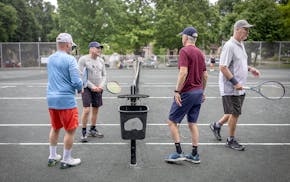The Minnesota Department of Transportation is issuing a warning to drivers using I-94 in Minneapolis: Starting next week, your typical commute could take significantly longer than usual.
Even at off-peak times there may be traffic snarls.
The freeway — already the epicenter of Twin Cities congestion — will have just two lanes open in each direction between I-35W and Franklin Avenue for the next six months.
A bridge maintenance and repair project kicked off this week with a few daylong ramp closures, but it swings into high gear Friday night with a weekend shutdown of all eastbound lanes between 35W and Franklin. Westbound lanes will remain open.
Drivers will be detoured onto northbound I-35W, eastbound Hwy. 36 and southbound I-35E, MnDOT said.
Thousands of weekday commuters on I-94 will likely feel the squeeze starting Monday at 5 a.m. when the eastbound lanes reopen. Motorists will have only two through lanes in each direction to use and all traffic will be shifted onto the eastbound lanes.
Popular westbound ramps directly leading to and from the University of Minnesota's East Bank campus, Augsburg University and the Cedar-Riverside neighborhood, and downtown Minneapolis will be closed through the summer.
With ramps at Huron Boulevard, Riverside Avenue and 7th Street closed, westbound drivers seeking to access downtown Minneapolis will be left with open exits at Cedar Avenue, 11th Street and Hennepin Avenue, or at Hwy. 55 on the north end of downtown.
Eastbound drivers will be able to use the Hennepin-Lyndale exit, then use city streets to circle back to reach downtown, or veer off I-94 onto northbound I-35W and exit at 3rd Street. They also have the option to get off before downtown at the exits for 4th and 7th streets N.
The ramp from Huron Boulevard to both eastbound and westbound 94 at the U will also be closed.
Drivers are likely to face extensive delays.
"The project is expected to add over 1 hour to typical commute times throughout the summer," an advisory from the University of Minnesota's Parking and Transportation Services said.
With more traffic likely diverting onto city streets, even motorists who don't travel on the freeway will feel the fallout.
"Give yourself additional time to reach your destination," MnDOT said. "Be patient. Expect delays, especially during peak travel times."
Between 123,000 and 146,900 vehicles a day travel through the 2½-mile segment where MnDOT will replace bridge joints, repair and repave bridge decks, replace guardrails and paint steel.
The $16 million project includes work on the Dartmouth Bridge spanning the Mississippi River, the Riverside Avenue bridge over I-94, and I-94 bridges over Cedar Avenue, Hwy. 55 and the Blue Line light-rail line and Hiawatha bike trail.
More travel headaches are in the future for Minneapolis motorists starting in July, when MnDOT begins repairing 34 bridges and ramps on I-394 between downtown Minneapolis and Hwy. 100 in St. Louis Park. That is one of about 180 projects MnDOT will carry out during the summer construction season.
Other big projects in 2025 include resurfacing I-35W in Burnsville, replacing or repairing bridges on I-494 in Edina and Richfield, and rebuilding Hwy. 5/W. 7th Street and Hwy. 61/Arcade Street in St. Paul.
MnDOT also will repair several bridges on I-94 and I-35E in St. Paul and add a third lane in each direction on Hwy. 10 in Coon Rapids.
In greater Minnesota, projects include concrete repair on Hwy. 12 between Litchfield and Cokato, finishing the Hinckley Bridge Replacement project on I-35, expanding Hwy. 10 to four lanes in Wadena and resurfacing Hwys. 29 and 71, and resurfacing eastbound I-94 between Rothsay and Fergus Falls.
MnDOT has reminded motorists to use the zipper merge at construction sites, obey the speed limit (a speeding fine in a work zone comes with a $300 fine), avoid making unnecessary lane changes and to not drive distracted. The agency also advised using its 511 web page and app to get current road and traffic conditions.
"With construction projects beginning in the coming weeks statewide, drivers should use caution as they see more work zones, more lane closures and orange cones – and most importantly more workers wearing their high-visibility safety gear along the highway," said Commissioner Nancy Daubenberger. "We're all safer when we pay close attention, slow down, remain patient and work together to safely share the limited space in a work zone."

South Minneapolis boasts the Twin Cities' first public clay tennis courts. These friends are raising money to build more.

Columbia Heights teen missing for three weeks likely being 'held against his will,' police say
St. Paul police investigating a homicide on the city's West Side
Metro Transit police, partner agencies announce initiative aimed at fixing Green Line safety problems

